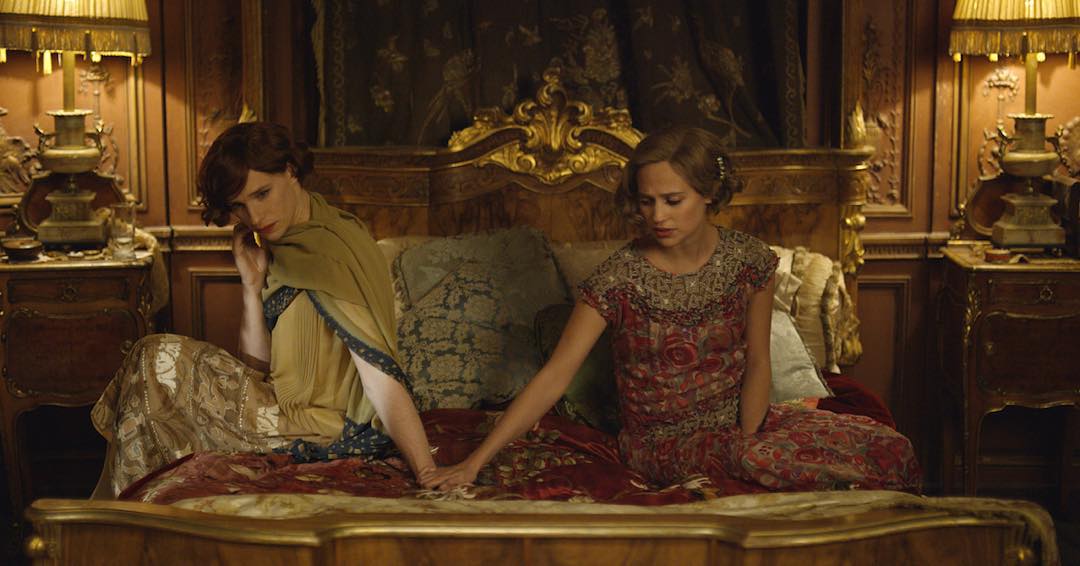The Danish Girl is a biographical romantic drama based on the novel of the same name written by David Ebershoff, depicting one of the first sexual reassignment surgeries performed in history. It follows the lives of Danish painters, Lili Elbe (born Einar Wegener) (played by Eddie Redmayne) and Gerda Wegener (played by Alicia Vikander), who reside in Copenhagen in the mid 1920s. Newly-married, all seems well with the couple as they seem to genuinely be in love with each other, reflected through their loving glances and embraces early on in the film. There seems to be a slight foreshadowing of events to come when Einar is backstage at a theatre, showing a deep fascination for fur costumes, and intensely gazing at Ulla Polsen (played by Amber Heard) — a close friend of the couple — while she rehearses.
However, something seems to spark when Gerda asks Einar to stand in for Ulla, who is the model for one of her portraits. After donning a pair of stockings, Einar has a profound emotional reaction, which sets off a series of events that cause him to question his gender identity. Ulla walks in on the couple and jokingly names Einar’s new ‘persona’ Lili.
On a whim, the couple then decide to attend a party with Einar dressed as Lili, who has been learning how to present himself as a woman in terms of dressing and mannerisms. Gerda has also begun painting portraits of Einar in his newfound feminine form.
Over here the audience witness Einar’s first foray into feminising himself, participating in an alternative gender performance. Taking Gerda’s lead, he studies female body language, adopting the way in which ladies tilt their heads and coyly avert the gazes of others, their posture and gait. What may be surprising to audiences here is Gerda’s support for her husband’s attempt at crossdressing as she buys him his own pair of stockings, and praises the way he does his makeup.
At the party, Gerda tells everyone that Lili is Einar’s cousin. At the party, Lili meets Henrik (played by Ben Whishaw) , who is immediately attracted to her. They share a kiss, and Einar becomes convicted of his newfound gender identity, which culminates in the scene where he is seen tucking his genitals to create the silhouette of a woman. Lili eventually finds that presenting as male is becoming too hard to bear, and he comes clean to Gerda, admitting that he identifies as a woman.
Lili thus begins her transition to align her body and gender expression with her inner gender identity. This is a herculean task, as doctors dismiss her as chemically imbalanced. She is threatened with incarceration, and is beaten up by homophobic thugs. Despite all this, Gerda remains supportive and continues to stay by her side.
At the recommendation of Lili’s childhood friend, Hans (played by Matthias Schoenaerts), Lili and Gerda seek the opinion of Dr Kurt Warnekros, who explains that he is familiar with individuals like Lili. He then proposes that Lili undergo a controversial procedure — a two part operation that would remove Lili’s male genitalia, and fashion a vagina thereafter. However, the catch is that such a procedure has never been performed before, and thus presents an extremely high risk. Nonetheless, Lili agrees to travel to Germany for the surgery, in a bid to “correct a mistake of nature”.
Although Lili eventually dies from complications resulting from the surgery, she remains a notable transgender pioneer till today.
Directed by Tom Hooper, the film has been applauded for its efforts in documenting the experiences of transgendered individuals, and providing an insight to the struggles they face as they work to align their physical appearance to their inner identities. Not only do they have to navigate the intricacies of ‘passing’ as another gender, but they are also beset with the negative reactions from the people around them. Furthermore, critics are also impressed by artistic filmography, which are highlighted through the picturesque scenery, and the attention to details in the costumes and sets.
Conversely, members of the trans community have also shown their disdain for the film, citing it as “regressive, reductive, and harmful” to trans representation in the media. In particular, Redmayne’s portrayal of Lili is perceived as a hypersexualised version of transwoman, as he is seen to mimic the body language of a stripper in his attempts to appear more convincingly feminine. The exaggeration of his female gender performance in the film can be argued as a performance of womanhood by stereotype.
In terms of exploring the emotional depth of the protagonist, the film also tends to fall short. It limits Lili’s most vulnerable and intricate thoughts to mere silences as she caresses female clothing, and fails to adequately capture the emotional turmoil that she goes through as she is subjected to multiple treatments and ridicule from those around her.
Overall, The Danish Girl seems to be a positive step in terms of trans representation in film, but requires a greater sensitivity towards the presentation and recounting of trans character’s experiences for it to be fully realised as a thought-provoking social commentary.





























